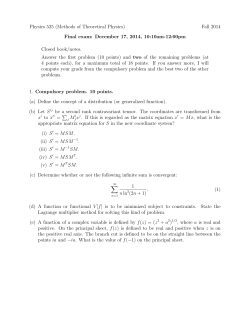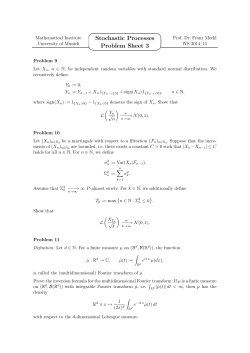
Section A
Chapter 17: Fourier Series Section A Introduction to Fourier Series By the end of this section you will be able to recognise periodic functions sketch periodic functions determine the period of the given function Why are Fourier series important? In today’s world of digital data we find Fourier series is used in signal processing such as audio, video, x-ray, sound and radar signals. Nearly any kind of repeated signal can be written as an infinite sum of sines and cosines. For example, if you record your voice for a second, we can find its Fourier series which may look something like this: voice sin t 1 1 sin 3t sin 5t 9 25 One application is MP3 which uses audio compression by removing a lot of the sounds in a song which our ears cannot hear. You take a sound, find its Fourier series which will be an infinite series but it converges so fast that taking the first few terms is enough to reproduce the original sound. This means that the remaining terms can be ignored because they add so little that a human ear cannot tell the difference. This means that we can save the first few terms and use them to reproduce the sound whenever we want to listen to it and it takes much less memory. It is computationally efficient because MP3 files are about 11 times smaller than uncompressed music tracks. The small size of the file means that you can easily download and email MP3 files. Another example is by considering the data generated by a person running on a force plate. As the force exerted on your feet from running is repeated so we can fit the data using Fourier series. This could lead to developing better running shoes. 1|Page Chapter 17: Fourier Series We have already expressed a given function f t as a series using the Maclaurin and Taylor expansions where we wrote f t in terms of polynomials. In similar manner we can expand a function which is periodic (repeats) by sine and cosine because these are periodic functions. A Fourier series is an expansion of a periodic function f t in terms of an infinite sum of sines and cosines. In general Fourier series can be used to examine practically any repeated (periodic) phenomenon, it characterizes something that repeats. By breaking down the coefficients in each term of the series (i.e. how large that term is in contributing to the total time series) one can characterize a complicated pattern by a group of numbers. Figure 1 Fourier is named after Joseph Fourier, 1768-1830, a French physicist who developed the theory in his work on heat conduction in 1822. He taught at the École Polytechnique in Paris which is the oldest institute of technology and science in the western world. In 1807 he stated that any periodic (repeated) function f t could be represented by the infinite series A cos kt B f t k 0 where k k sin kt (‡) represents the sum from k 0 to . k 0 Thus a Fourier series decomposes repeated (periodic) signals into an infinite sum of sines and cosines. 2|Page Chapter 17: Fourier Series Our aim in this chapter is to find the Fourier series which corresponds to a given repeated (periodic) function. We have to work out the constants Ak and Bk in the above expression (‡). Usually, a theory is first developed in mathematics and later an application is found for it in engineering. Fourier series is an example of a theory developed first for engineers/physicists, and only later used by mathematicians. In the above we have used the term periodic function so in this section we define what is meant by periodic function and how to evaluate the period for a given function. A1 Periodic Functions The following are all examples of periodic functions: Graph A Graph B Graph C Figure 2 What do the graphs of Fig. 2 have in common? 3|Page Chapter 17: Fourier Series They repeat the same pattern after a particular time. Graphs A and B repeat every 2 units and Graph C repeats every 5 units. Writing this in mathematical notation we have: A function f is called a periodic function of period P if for all t f t P f t (17.1) The following is a graph of a function f t with period P. Figure 3 Generally a periodic function is one which repeats itself after a time P. The smallest positive value of P is called the period of the function. What is the period of the function in Fig 3? Period 2 With this we can demonstrate what we mean by ( + ) = ( ) where = = 2 . At we can see from the graph in Figure 3 that ( ) = 1, well now we look at ( + 2 ) = (3 ) = 1. So we see see that ( ) = (3 ) = 1. This is what we mean by periodic, the value of the function at a time is the same as at the time ( + ). Can you think of any examples of periodic functions? The trigonometric functions sin, cos and tan are all examples of periodic functions. 4|Page Chapter 17: Fourier Series sin t Figure 4 What period does the sine graph have? 2 because the graph repeats itself after an interval of 2 . You might be tempted to believe that the function has period since f 0 f 0 However, this can’t be the period since it doesn’t hold for all t. for example 3 f 1 but f 1 , so f 2 2 2 3 f 2 Can you think of any functions that are not periodic? The functions t, t 2 and e t are not periodic functions. et Figure 5 The graph of e t does not repeat itself as you can see in Fig. 5, hence it is not a periodic function. 5|Page Chapter 17: Fourier Series Example 1 Sketch the graph f t for t 0 given by: 1 f t 1 which has a period of 0 t 3 3 t 2 3 2 2 . You might see this written as f t f t . 3 3 Solution We first sketch the graph between 0 and 2 . What does f t look like for this 3 interval? To answer this question you need to understand the mathematical notation of f t . The notation says that f t is 1 between 0 and 2 and it is 1 between and . 3 3 3 Therefore we have f t 1 0 -1 Figure 6 We have to use dotted lines at a couple of places in our graph because of the jump in the function. The first part of our function tells us the behaviour when < , not . Similarly, the second part of the function tells us the behaviour of the function when > , not, ≥ . This means that when = ≤ we don’t have a value for the function, so we have a ‘jump’ in the function, to illustrate this we use a dotted line. Such a jump is often called a discontinuity. The same happens when Beyond = . 2 2 the function f t repeats the same pattern every units because we are 3 3 given that the period is equal to 2 . Hence we have 3 6|Page Chapter 17: Fourier Series 1 -1 Figure 7 Example 2 Determine the period of the following function: t (secs) 0 Figure 8 Solution Clearly the period is 2 seconds because the graph repeats itself every 2 seconds. Example 3 Determine the period of the following function: f t 1 t -1 Figure 9 Solution Finding the period of the function in Fig. 9 is more challenging than in Example 2. We need to evaluate after what interval does the graph repeat itself. Just after = −5 the 7|Page Chapter 17: Fourier Series value of f t is 1 and it is again 1 just after t 15 . Therefore the period is equal to 15 5 20 (since 20 units have passed). SUMMARY A periodic function is a function which repeats itself. This can be written as f t f t P The smallest positive value of P is called the period of the function. 8|Page
© Copyright 2025









